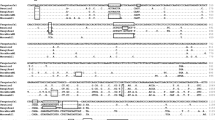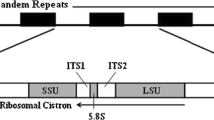Abstract
The molecular organization of the 5S rRNA gene family has been studied in a wide variety of animal taxa, including many bony fish species. It is arranged in tandemly repeated units consisting of a highly conserved 120 base pair–long region, which encodes for the 5S rRNA, and a nontranscribed spacer (NTS) of variable length, which contains regulatory elements for the transcription of the coding sequence. In this work, a comparative analysis of 5S ribosomal DNA (rDNA) organization and evolution in the 12 species of the genus Merluccius, which are distributed in the Atlantic and Pacific oceans, was carried out. Two main types of 5S rDNA (types A and M) were identified, as differentiated by the absence or presence of a simple sequence repeat within the NTS. Four species exhibited the 2 types of 5S rDNA, whereas the rest showed only 1 type. In addition, the species M. albidus and M. bilinearis showed 2 variants (S and L) of type-M 5S rDNA, which differentiated by length. The results obtained here support the hypothesis of a 5S rRNA dual system as an ancient condition of the Piscine genome. In contrast, some inconsistencies were found between the phylogeny of the genus Merluccius based on mitochondrial genes and that obtained from nuclear markers (5S rDNA, microsatellite loci, and allozyme data). Hybrid origin of the American species M. australis is suggested based on these results.



Similar content being viewed by others
References
Amici A, Rollo F (1991) The nucleotide sequence of the 5s ribosomal RNA gene of Pyrenophora graminea. Nucleic Acids Res 19:5073
Baack EJ, Rieseberg LH (2007) A genomic view of introgression and hybrid speciation. Curr Opin Genet Dev 17:513–518
Bogenhagen DF, Brown DD (1981) Nucleotide sequences in Xenopus 5S DNA required for transcription termination. Cell 14:261–270
Bogenhagen DF, Sakonju S, Brown DD (1980) A control region in the center of the 5S RNA gene directs specific initiation of transcription. II. The 3′border of the region. Cell 19:27–35
Brown DD, Carroll F, Brown RD (1977) The isolation and characterization of a second oocyte 5S DNA from Xenopus laevis. Cell 12:1045–1056
Campo D, Machado-Schiaffino G, Perez J, García-Vázquez E (2007) Phylogeny of the genus Merluccius based on mitochondrial and nuclear genes. Gene 406:171–179
Cassidy JR, Pukkila PJ (1987) Inversion of 5S ribosomal RNA genes within the genus Coprinus. Curr Genet 12:33–36
Castillo AGF, Martinez JL, Garcia-Vazquez E (2004) Fine spatial structure of Atlantic hake (Merluccius merluccius) stocks revealed by variation at microsatellite loci. Mar Biotechnol 6:299–306
Cihlar RL, Sypherd PS (1980) The organization of the ribosomal RNA genes in the fugus Mucor racemosus. Nucleic Acids Res 8:793–804
Cimmaruta R, Bondanelli P, Nascetti G (2005) Genetic structure and environmental heterogeneity in the European hake (Merluccius merluccius). Mol Ecol 14:2577–2591
Drouin G, Moniz de Sà M (1995) The concerted evolution of 5S ribosomal genes linked to the repeat units of other multigene families. Mol Biol Evol 12:481–493
Dover GA (1982) Molecular drive: a cohesive model of species evolution. Nature 299:111–117
Duchesne LC, Anderson JB (1990) Location and direction of the 5S rRNA gene in Armillaria. Mycol Res 94:266–269
Egger B, Koblmüller S, Sturmbauer C, Sefc KM (2007) Nuclear and mitochondrial data reveal different evolutionary processes in the Lake Tanganyika cichlid genus Tropheus. BMC Evol Biol 7:137
Estoup A, Largiadèr CR, Perrot E, Chourrout D (1996) Rapid one-tube DNA extraction for reliable PCR detection of fish polymorphic marker and transgenes. Mol Mar Biol Biotechnol 5:295–298
Felsenstein J (1985) Confidence limits on a phylogenies: an approach using the bootstrap. Evolution 39:783–791
Felsenstein J (1989) PHYLIP-Phylogenty Inference Package (Version 3.2). Cladistics 5:164–166
Ganal MW, Lapitan NLV, Tanksley SD (1988) A molecular and cytogenetic survey of repeated DNA sequences in tomato (Lycopersicon esculentum). Mol Gen Genet 213:262–268
Gornung E, Colangelo P, Annesi F (2007) 5S ribosomal RNA genes in six species of Mediterranean grey mullets: genomic organization and phylogenetic inference. Genome 50:787–795
Grant WS, Leslie RW (2001) Inter-ocean dispersal is an important mechanism in the zoogeography of hakes (Pisces: Merluccius spp.). J Biogeogr 28:699–721
Hall TA (1999) BioEdit: a user-friendly biological sequence alignment editor and analysis program for Windows 95/98/NT. Nucleic Acids Symp Ser 41:95–98
Hasegawa M, Kishino K, Yano T (1985) Dating the human-ape splitting by a molecular clock of mitochondrial DNA. J Mol Evol 22:160–174
Huelsenbeck JP, Ronquist FR (2001) Mrbayes: Bayesian inference of phylogeny. Bioinformatics 17:754
Koblmüller S, Duftner N, Sefc KM, Aibara M, Stipacek M, Blanc M, Egger B, Sturmbauer C (2007) Reticulate phylogeny of gastropod-shell-breeding cichlids from Lake Tanganyika—the result of repeated introgressive hybridization. BMC Evol Biol 7:7
Komiya H, Hasegawa M, Takemura S (1986) Differentiation of oocyte- and somatic-type 5S rRNAs in animals. J Biochem 100:369–374
Kramer R, Philippsen P, Davis RW (1978) Divergent transcription in the yeast ribosomal RNA coding region as shown by hybridization to separated strands and sequence analysis of cloned DNA. J Mol Biol 123:405–416
Leaché AD, McGuire JA (2006) Phylogenetic relationships of horned lizards (Phrynosoma) based on nuclear and mitochondrial data: evidence for a misleading mitochodnrial gene tree. Mol Phylogenet Evol 39:628–644
Lundy CJ, Moran P, Rico C, Milner RS, Hewitt GM (1999) Macrogeographical population differentiation in oceanic environments: a case study of European hake (Merluccius merluccius), a commercially important fish. Mol Ecol 8:1889–1898
Machado-Schiaffino G, Garcia-Vazquez E (2009) Isolation and characterization of microsatellite loci in Merluccius australis and cross-species amplification. Mol Ecol Res 9:585–587
Martins C, Galetti M Jr (2001) Organization of 5S rDNA in species of the fish Leporinus: Two different genomic locations are characterized by distinct nontranscribed spacers. Genome 44:903–910
Morán P, Martínez JL, García-Vázquez E, Pendás AM (1996) Sex linkage of 5S rDNA in rainbow trout (Oncorhynchus mykiss). Cytogenet Cell Genet 75:145–150
Morán P, Lundy CJ, Rico C, Hewitt GM (1999) Isolation and characterization of microsatellite loci in European hake, Merluccius merluccius (Merluccidae, Teleostei). Mol Ecol 8:1357–1358
Müller K (2005) SeqState—primer design and sequence statistics for phylogenetic DNA data sets. Appl Bioinformatics 4:65–69
Nedi MS, Rajagopal J, Chauhan N, Cronn R, Lakshmikumaran M (2002) Length and sequence heterogeneity in 5S rDNA of Populus deltoides. Genome 45:1181–1188
Nylander JAA (2004) MrModeltest v2. Program distributed by the author. Evolutionary Biology Centre, Uppsala University, Uppsala, Sweden
Pasolini P, Costagliola D, Rocco L, Tinti F (2006) Molecular organization of 5S rDNA in Rajidae (Chondrichthyes): structural features and evolution of Piscine 5S rRNA genes and nontranscribed intergenic spacers. J Mol Evol 62:564–574
Pendás AM, Morán P, Freije JP, García-Vázquez E (1994) Chromosomal mapping and nucleotide sequence of two tandem repeats of Atlantic salmon 5S rDNA. Cytogenet Cell Genet 67:31–36
Pérez J, García-Vázquez E (2004) Genetic identification of nine hake species for detection of commercial fraud. J Food Prot 67:2792–2796
Pérez M, Vieites JM, Presa P (2005) ITS1-rDNA-based methodology to identify world-wide hake species of the genus Merluccius. J Agric Food Chem 53:5239–5247
Pitcher TJ, Alheit J (1995) What makes a hake? A review of the critical biological features that sustain global hake fisheries. In: Alheit J, Pitcher TJ (eds) Hake: biology, fisheries and markets. Chapman & Hall, London
Quinteiro J, Vidal R, Rey-Méndez M (2000) Phylogeny and biogeographic history of hake (genus Merluccius) inferred from mirochondrial DNA control region sequences. Mar Biol 136:163–174
Rambaut A (2008) FigTree v1.1.2. Available at: http://tree.bio.ed.ac.uk/software/figtree
Rico C, Ibrahim KM, Rico I, Hewitt GM (1997) Stock composition in North Atlantic populations of whiting using microsatellite markers. J Fish Biol 51:462–475
Robles F, de la Herrán R, Ludwig A, Rejón CR, Rejón MR, Garrido-Ramos MA (2005) Genomic organization and evolution of the 5S ribosomal DNA in the ancient fish sturgeon. Genome 48:18–28
Roldán MI, García-Marín JL, Utter FM, Pla C (1999) Genetic relationships among Merluccius species. Heredity 83:79–86
Sajdak SL, Reed KM, Phillips RB (1998) Intraindividual and interspecies variation in the 5S rDNA of coregonid fish. J Mol Evol 46:680–688
Simmons MP, Ochoterna H (2000) Gaps as characters in sequence-based phylogenetic analyses. Syst Biol 49:369–381
Sola L, Rossi AR, Annesi F, Gornung E (2003) Cytogenetic studies in Sparus aurata (Pisces, Perciformes): molecular organization of 5S rDNA and chromosomal mapping of 5S and 45S ribosomal genes and of telomeric repeats. Hereditas 139:232–236
Stepien C, Rosenblatt RH (1996) Genetic divergence in antitropical pelagic marine fishes (Trachurus, Merluccius and Scomber) between North and South America. Copeia 3:586–589
Swofford DL (2003) PAUP*: phylogenetics analysis using Parsimony (and other methods). Version 4. Sinauer Associates, Sunderland
Tabata S (1980) Structure of the 5S ribosomal RNA gene and its adjacent regions in Torulopsis utilis. Eur J Biochem 110:107–114
Teletchea F, Laudet V, Hänni C (2006) Phylogeny of the Gadidae (sensu Svetovidov 1948) based on their morphology and two mitochondrial genes. Mol Phylogenet Evol 38:189–199
Thompson JD, Higgins DG, Gibson TJ (1994) CLUSTAL W: improving the sensitivity of progressive multiple sequence alignment through sequence weighting, position specific gap penalties and weight matrix choice. Nucleic Acids Res 22:4673–4680
Ting N, Tosi AJ, Li Y, Zhang Y, Disotell TR (2008) Phylogenetic incongruence between nuclear and mitochondrial markers in the Asian colobines and the evolution of the langurs and leaf monkeys. Mol Phylogenet Evol 46:466–474
von der Heyden S, Lipinski MR, Matthee CA (2007) Mitochondrial DNA analyses of the Cape hakes reveal an expanding, panmictic population for Merluccius capensis and population structuring for mature fish in Merluccius paradoxus. Mol Phylogenet Evol 42:517–527
Wasko AP, Martins C, Wright JM, Galetti PM Jr (2001) Molecular organization of 5S rDNA in fishes of the genus Brycon. Genome 44:893–902
Acknowledgments
Hake samples were kindly provided by Francis Juanes (University of Massachusetts), Ignacio Sobrino (Instituto Español de Oceanografia Cadiz, Spain), Luis O. Bala (Consejo Nacional de Investigaciones Cientificas y Tecnicas, Argentina), Mauricio Ponte (University of Santiago, Chile), Francisco Sanchez (Instituto Español de Oceanografia Santander, Spain), Robin Tilney (Department of Environmental Affairs, Cape Town, South Africa), and Eduardo Vallarino (University of Mar del Plata, Argentina).
Author information
Authors and Affiliations
Corresponding author
Rights and permissions
About this article
Cite this article
Campo, D., Machado-Schiaffino, G., Horreo, J.L. et al. Molecular Organization and Evolution of 5S rDNA in the Genus Merluccius and Their Phylogenetic Implications. J Mol Evol 68, 208–216 (2009). https://doi.org/10.1007/s00239-009-9207-8
Received:
Revised:
Accepted:
Published:
Issue Date:
DOI: https://doi.org/10.1007/s00239-009-9207-8




